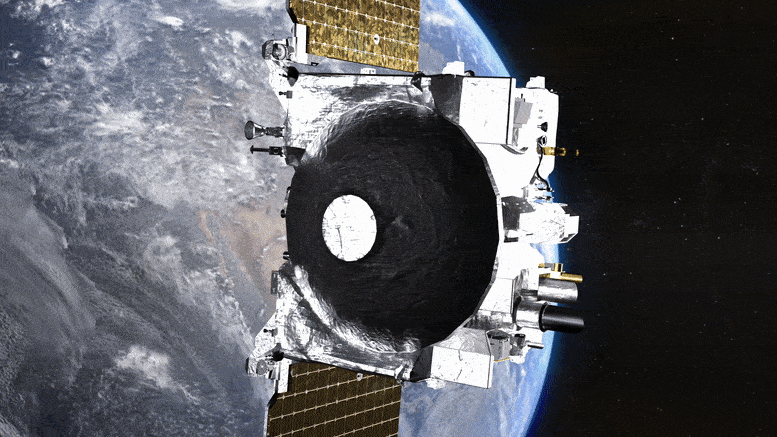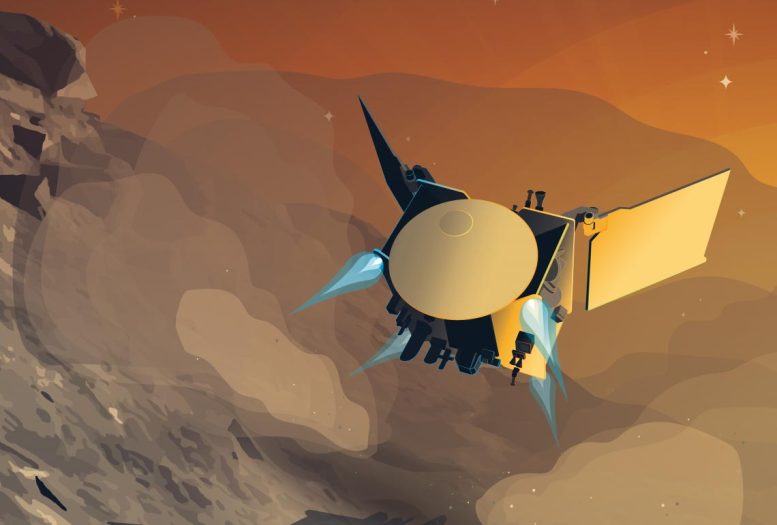
The spacecraft bids farewell to Earth and embarks on an extended mission with a new name: OSIRIS-APEX. Credit: NASA’s Goddard Space Flight Center Conceptual Image Lab
NASA’s OSIRIS-REx spacecraft completed its final task for this mission when it released its sample capsule toward Earth less than an hour ago. About 20 minutes after doing so, the spacecraft fired its engines to divert past Earth toward its new mission to asteroid Apophis and was renamed OSIRIS-APEX.
Roughly 1,000 feet wide, Apophis will come within 20,000 miles of Earth – less than one-tenth the distance between Earth and the Moon – in 2029. OSIRIS-APEX is scheduled to enter orbit of Apophis soon after the asteroid’s close approach of Earth to see how the encounter affected the asteroid’s orbit, spin rate, and surface.

This is an artist’s illustration of the OSIRIS-REx spacecraft firing thrusters near the surface of the asteroid Apophis. Credit: Heather Roper
Delving into the OSIRIS-APEX Mission: From Bennu to Apophis
The OSIRIS-REx spacecraft, under NASA’s leadership, has completed its principal objective of collecting a sample from the asteroid Bennu. But, the journey doesn’t end here. In a bid to further explore the mysteries of our solar system, the spacecraft is now transitioning into its extended mission, OSIRIS-APEX.
From Earth Flyby to Apophis Encounter
Today, OSIRIS-REx will briefly grace our skies, flying by Earth to deliver its precious sample from Bennu. But the exploration drive is far from over. Instead of retiring after its Earth rendezvous, the spacecraft will embark on a new quest: to study the near-Earth asteroid, Apophis. This asteroid is set for a dramatic close encounter with Earth in 2029, and OSIRIS-APEX aims to be there, understanding its intricacies.

On Friday, 13 April 2029, the infamous asteroid Apophis will make a close approach of Earth. Passing at a distance less than 40,000 km, it will be visible to the naked eye. At this distance, Earth’s gravity will have a notable impact on the passing space rock, altering its path and amplifying the uncertainty in its orbit. Until recently, there was a small chance that this close approach could nudge Apophis into a dangerous new orbit, in which the 350 m asteroid could strike Earth in a future journey round the Sun. Credit: ESA
Apophis: The Infamous Asteroid
Apophis stands out in the asteroid community. Discovered in 2004, it initially posed a potential threat of impacting Earth during its 2029 close approach. Although subsequent observations alleviated these concerns, the 2029 encounter still remains significant. It will mark one of the closest approaches by an asteroid of this magnitude. Europe and Africa will bear witness to this celestial event, with residents having the privilege to observe Apophis with the naked eye.
Mission Objectives of OSIRIS-APEX
Launched in 2016, OSIRIS-REx’s initial mission was to aid scientists in understanding the solar system’s formation and Earth’s habitability by collecting a sample from Bennu. As for OSIRIS-APEX, while there is no intent to gather a sample from Apophis, the mission aims to study the asteroid intensively for 18 months. The spacecraft will approach the asteroid’s surface, fire its thrusters, exposing the subsurface, thus giving scientists a glimpse of Apophis’s material properties.
Additionally, the mission seeks to comprehend the effects of Earth’s gravitational pull on Apophis during its 2029 near-approach and to differentiate its composition from Bennu.









When the Osiris fires it’s thrusters when landing on Apophis, could this nudge the asteroid into a closer approach to Earth?